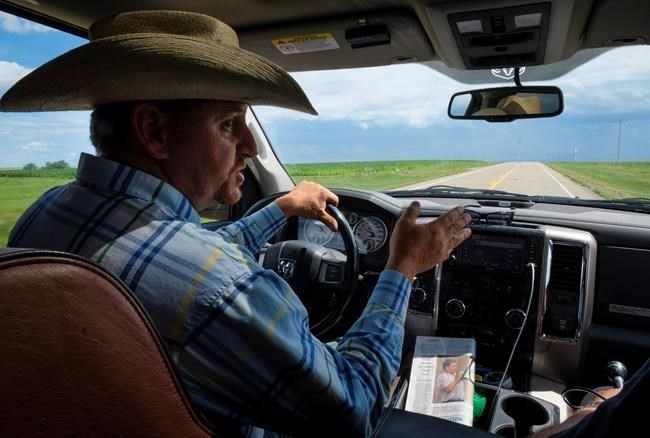
Rancher Jeff Lewandoski, who's ranch borders CFB Suffield, Alta., talks about the elk problem on the base and his land, Tuesday, July 26, 2016.
Image Credit: THE CANADIAN PRESS/Jeff McIntosh
August 01, 2016 - 11:30 AM
SUFFIELD, Alta. - Jeff Lewandoski has a grudging admiration for his biggest enemy but equates the annual elk arrival at his sprawling ranch in southeastern Alberta to that of unwelcome relatives who show up unannounced.
"Every day and all summer long you can chase them away and they still come back," said Lewandoski with a laugh.
Lewandoski has 1,200 hectares and 200 head of cattle on his property at Jenner on the northern edge of Canadian Forces Base Suffield.
The elk were brought to the base in the 1990s after 1,200 wild horses were removed because it was believed they were damaging the grassland ecosystem. Since elk were native to the area it was thought they would keep the grass under control but would do less damage.
However, the initial herd of 200 elk exploded to more than 8,000 animals.
"The elk were kind of a novelty. It was kind of neat to see them when there was only four or five showing up but now, the last five years, we get anywhere from 25 to 100 in here everyday," Lewandoski said.
"They're night grazers. They can just destroy our crops overnight, pretty much just like a lawnmower."
They also knock down fences and there are concerns the elk could spread tuberculosis and brucellosis to cattle.
The Alberta government began issuing hunting tags for the military base, beginning with 200 in 2012 all the way up to 2,100 last fall.
Lt.-Col. John Scott, the base commander, said 1,600 elk were killed last year at Suffield and an additional 300 were taken from surrounding wildlife management areas.
The number of elk at Suffield and the surrounding area is now pegged at about 5,400, but Scott said it needs to be lower.
"Based on what I've seen and read from some of the surrounding municipalities, I think they're looking more at a thousand as the end state. But that's a provincial decision," he said.
An official with Alberta Environment and Parks said there's been a 35 per cent reduction in the herd since 2014.
"Our goal is to get the herd down to around 3,500 in early 2017 and then we'll develop a management plan with the base and stakeholders to get their input to what the number should be," said regional resource manager Rob Simieritsch.
Lewandoski has given hunters full access to his property but wants something more drastic.
"We have to gather three-quarters of this herd and either transplant them to areas of the province that are out of elk or, since we have a bad economy right now, let's fill the food banks with meat."
Simieritsch said a cull was rejected because of a negative public response.
That's not a surprise to Lewandoski.
"These city people don't understand what's going on here. In the country we don't have a voice. There's so few of us and you get 90 per cent of those in town who don't want to cull these elk, then that's what's going to happen."
The hunt next season will be staggered. Scott said the first couple of weeks is like "shooting fish in a barrel" but it doesn't take the elk long to clue in.
"The elk aren't stupid. If you start shooting at them they're going to move to where they're not getting shot," he said.
Thanks to heavy rainfall this year the grazing has been so good on the base the elk haven't been as much of a problem.
Lewandoski is relieved.
"It was all I could think about in May or June, because all I could see coming over the hill is a bunch of elk and I'm like, here we go again," he said.
"There was a couple of years there where I was ready to pull every hair out."
News from © The Canadian Press, 2016